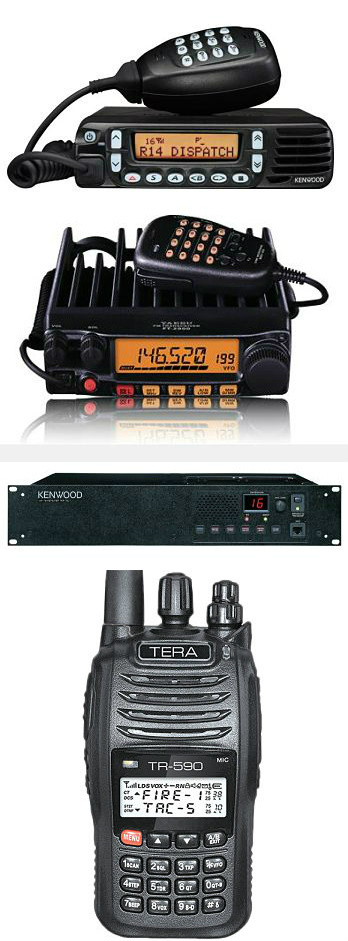


My favorite Star Trek Movie of all is Star Trek IV - The Voyage Home - in which Admiral Kirk and a few
of the Executive crew have to travel back through time to the 20th Century to retrieve two Humpback Whales
 to take back to the Earth of the future so that an alien probe in their century will receive an intelligible
answer to it's query and stop probing the Earth's oceans - an action which, if continued, would inadvertently
kill all the inhabitants of the planet. In one scene (after their return to the late 20th century) Scotty,
strutting his "engineering prowess" to Dr. Nichols
during his visit to Plexicorp, offers him the formula for "Transparent Aluminum", a material with the strength of Plexiglass
six times its thickness. "Why are we discussing Star Trek in a GMRS Blog?" you might ask. Well, for one, the Star Trek franchise
of movies has an awesome number of real life analogies and, well, because this is my blog post and I like Star Trek. Plus it relates to the
subject. That's why my story about Star Trek would be pointless without an application to the content of this
article. So hang in there and I'll get to it. In the mean time, try not to think about the endless-loop paradox
Commander Scott may have accidentally triggered.
to take back to the Earth of the future so that an alien probe in their century will receive an intelligible
answer to it's query and stop probing the Earth's oceans - an action which, if continued, would inadvertently
kill all the inhabitants of the planet. In one scene (after their return to the late 20th century) Scotty,
strutting his "engineering prowess" to Dr. Nichols
during his visit to Plexicorp, offers him the formula for "Transparent Aluminum", a material with the strength of Plexiglass
six times its thickness. "Why are we discussing Star Trek in a GMRS Blog?" you might ask. Well, for one, the Star Trek franchise
of movies has an awesome number of real life analogies and, well, because this is my blog post and I like Star Trek. Plus it relates to the
subject. That's why my story about Star Trek would be pointless without an application to the content of this
article. So hang in there and I'll get to it. In the mean time, try not to think about the endless-loop paradox
Commander Scott may have accidentally triggered.
We have all seen those Motorola (and other brand) radios affectionately (or not so affectionately) referred to
as "bricks" - you know, radios like the HT-200 or the MX-340 (shown below). At one time they were considered cutting
edge and that's what people carried if they wanted 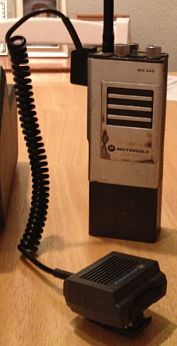 to talk via two-way radio
when away from the base or their vehicles.
While current radios from major brands (including Motorola, Kenwood, Icom and Vertex-Standard) have gotten much smaller
and lighter, they still seem bulky and heavy by some peoples' standards. "Who would think that?" you might ask.
to talk via two-way radio
when away from the base or their vehicles.
While current radios from major brands (including Motorola, Kenwood, Icom and Vertex-Standard) have gotten much smaller
and lighter, they still seem bulky and heavy by some peoples' standards. "Who would think that?" you might ask.
Those of us who have spouses (or other companions of the feminine persuasion) probably know full well how difficult it is to
encourage your gal to even talk on the radio, much less be seen carrying a radio in her purse or on her person.
 She'll carry a phone
that rivals the size of a small flat-screen TV, but not a radio. Go figure. If my wife is any example, I suspect many of you have experienced
this reluctance by your spouse/loved one to embrace the GMRS lifestyle in a similar way: So, here's how my story goes - maybe it will
resonate with you…
She'll carry a phone
that rivals the size of a small flat-screen TV, but not a radio. Go figure. If my wife is any example, I suspect many of you have experienced
this reluctance by your spouse/loved one to embrace the GMRS lifestyle in a similar way: So, here's how my story goes - maybe it will
resonate with you…
I bought a pair of Vertex VX-231-series radios on E-Bay and had ProComm tune and align them, and programmed them for the Club Repeater plus a few other GMRS frequencies. My goal was to have Cindy carry one with her so we could stay in contact at the mall or grocery store or our favorite Warehouse Club without having to constantly dial each other up on the cell phone. Unfortunately, she felt the Vertex was too big and heavy to lug around in her purse. Then I tried a Powerwerx DB-16. Same response. Tera TR-500 or TR-505, ditto. TecNet TS-2000 series and TS-3000 series. Repeat of same response. My Kenwood TK-3312K2 is even bigger and heavier than most of the aforementioned radios, so I knew automatically that would never fly either. What a quandary!
Because my inspiration to create a GMRS club in Phoenix was so that families could communicate through repeaters using quality two-way radios (without requiring every family member to obtain a Ham license) I was somewhat dismayed when the weight and size of most modern radios would not allow my goal to be realized within my own family! Fast forward to about a month ago when - at work - we received an ad for a new product Maxon was coming out with: the TPD-8000 series. When I saw the specifications, I was reminded of that scene from Star Trek. Just like plexiglass was the state of the art for a transparent whale enclosure that Admiral Kirk and his crew needed, we've all gotten used to the idea that current models of Kenwood, Icom, Vertex and Motorola handheld radios are the "best we have" for GMRS use. Now however, like Commander Scott, I can say with confidence, "What if I could show you something that would do the same job at just 1" thick?" and "Aye, indeed, now would that be worth something to you or should I just click delete?" (paraphrase mine)
EXCEPT for one thing: The little gem I am going to preview for you is even thinner than that! Although it doesn't pack the same 5-watt wallop as the "regular radios" we all carry every day, it's diminutive size and light weight belie its motherlode of features. The reason I am so excited about this radio is because of my wife's reaction to it. Maxon sent ProComm a couple of "mock-up" radios for us to look at and show to customers: one in Orange and another in Blue. They are exactly the same as the finished product will be in appearance and weight but have no electronics inside, so they're non-functional (of course). I brought one home to Cindy and her reaction exceeded my wildest expectations! She said something like "Now THIS is a radio I could carry with me!" and slipped it in her pocket right away to see how it fits. PERFECT! Now a solution is available for any club member whose spouse won't carry a radio with her because of the size and weight of previously available radios. Plus it's really, really cute and is loaded with features.
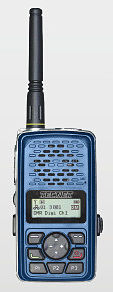
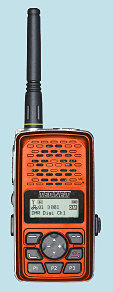
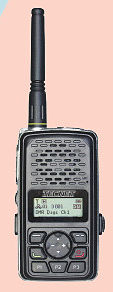 Available in three colors: Blue, Orange and Black, the TPD-8124 is the VHF version and the TPD-8424 is the UHF version.
The hams among us will be interested in both, since both the VHF and the UHF models cover a frequency range down into the ham bands. However, since GMRS operates
over UHF, for sake of the average club member I want to focus on the TPD-8424.
Available in three colors: Blue, Orange and Black, the TPD-8124 is the VHF version and the TPD-8424 is the UHF version.
The hams among us will be interested in both, since both the VHF and the UHF models cover a frequency range down into the ham bands. However, since GMRS operates
over UHF, for sake of the average club member I want to focus on the TPD-8424.
Let's talk about the basics of this latest offering from Maxon, which will be shipping in February 2017:
Dual-Service Radio: I said earlier, the radio covers down into the Ham band. The exact frequency range is 440-470 MHz and it works on both Analog
and DMR (Digital Mobile Radio). While DMR is illegal to use on GMRS, it is of great value to Hams who want to take advantage of Digital Radio in the 70 CM
Amateur band.
Power Level: The fact that the TPD-8424's RF power output is 2 Watts on Analog and 3 Watts on Digital is understandable considering its size - which we
will get to later. Because 2 watts on Analog is about half the power of the other radios mentioned here, the range on simplex would be correspondingly less under
similar conditions. However if you're using a repeater, that all changes because the repeater does all the "heavy lifting". I would expect, for example, from
inside Arrowhead Mall we would be able to hit the White Tanks repeater, and from Desert Ridge Mall I would expect to be able to hit the Scottsdale repeater. One
should be able to hit either repeater from inside a car or even inside most office buildings around the valley. When ProComm receives their shipment of working
models I'll do some exhaustive testing and let you know what results I get.
Channel Capacity: When I said that this radio has "a motherlode of features" I wasn't exaggerating. Let's start with channel capacity. The TPD-8424 has a
channel capacity of 512 channels. They are spread among 16 zones with a maximum of 32 channels per zone. Since GMRS uses just 15 channels, you can see that there
is plenty of channel capacity to load up just about every conceivable repeater and simplex combination of frequencies and tones you can imagine.
Other Features: You can read the rest of the specifications from the
factory brochure, but the most exciting feature to me was the size (3.98"H x 2"W x .82"T)and weight (5.86 Oz).
Warranty: While Kenwood, Icom and Motorola pretty much only offer a two-year warranty on their analog radios this Maxon radio has a three-year warranty,
which mirrors Kenwood's three- year warranty on digital radios and Vertex's three-year warranty on analog radios. (Most manufacturers offer only a one-year on
accessories.)
About the Manufacturer: Many of you who have been around radio for any length of time will remember the "Maxon" brand that appeared in the mid 70's and really
gained momentum in the 80's through the late 90's. They offered both Land Mobile Radio products and Consumer Electronics devices as well. Through the years they went
through various changes and recently the supplier of Maxon data radio products, TecNet International, Inc. (based in Lenexa, KS), changed its name to "Maxon America, Inc."
and will continue to produce the TecNet branded products under the Maxon name. You can read the full story here but suffice it to say that the Maxon brand returning
to the forefront of the American LMR scene is a good thing, especially when you actually get to see the production TPD-8424 in person!
Next month, with a real TPD-8424 in hand, I'll do an actual product review of the radio including comparisons to several other models and brands.
 About the Author: A radio experimenter since 1965 and a ham radio operator (WD8QLB - Novice, N7EGK - Technician) since 1976, I have been involved in radio
one way or the other since my youth. My involvement in GMRS started on a trip to Pass Christian Mississippi with one of the crews rebuilding homes and doing cleanup
after Hurricane Katrina. We used GMRS radios on site for communications. Licensed as WQCE415, I let my license expire (stupid move on my part) but got re-licensed as
WQRV903 in 2013 at which time I began the work of establishing a GMRS repeater club. That groundwork led to a group of about 10-12 "Founders" creating the association
now known as The Arizona GMRS Repeater Club. For my "day job"
I am employed by ProComm, Division of Southwest Radio Sales, Inc.
as the Operations/Office Manager. My wife and I own
Studio902 Web Solutions, a Domain Name and Web Hosting Sales company. We alsdesign custom websites.
I serve the GMRS Community by providing assistance in any way possible. ProComm offers a 15% discount off MSRP of any regularly stocked / regularly sold items for any active member of AGRC.
About the Author: A radio experimenter since 1965 and a ham radio operator (WD8QLB - Novice, N7EGK - Technician) since 1976, I have been involved in radio
one way or the other since my youth. My involvement in GMRS started on a trip to Pass Christian Mississippi with one of the crews rebuilding homes and doing cleanup
after Hurricane Katrina. We used GMRS radios on site for communications. Licensed as WQCE415, I let my license expire (stupid move on my part) but got re-licensed as
WQRV903 in 2013 at which time I began the work of establishing a GMRS repeater club. That groundwork led to a group of about 10-12 "Founders" creating the association
now known as The Arizona GMRS Repeater Club. For my "day job"
I am employed by ProComm, Division of Southwest Radio Sales, Inc.
as the Operations/Office Manager. My wife and I own
Studio902 Web Solutions, a Domain Name and Web Hosting Sales company. We alsdesign custom websites.
I serve the GMRS Community by providing assistance in any way possible. ProComm offers a 15% discount off MSRP of any regularly stocked / regularly sold items for any active member of AGRC.